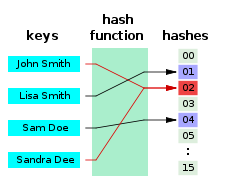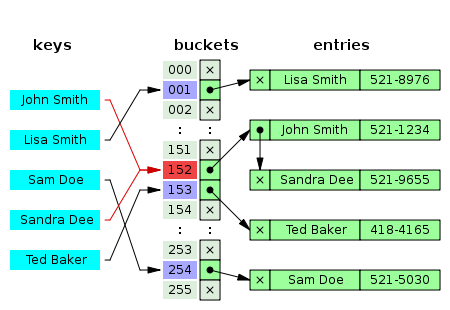一、维基百科怎么说
A hash function is any function that can be used to map data of arbitrary size to data of fixed size. The values returned by a hash function are called hash values, hash codes, hash sums, or simply hashes. One use is a data structure called a hash table, widely used in computer software for rapid data lookup.
- map 映射
- 处理固定长度
- return 任意长度
- 被广泛用于快速检索


二、java Object 怎么说
public int hashCode()
Returns a hash code value for the object. This method is supported for the benefit of hash tables such as those provided by
HashMap.
The general contract of hashCode is:
- Whenever it is invoked on the same object more than once during an execution of a Java application, the
hashCodemethod must consistently return the same integer, provided no information used inequalscomparisons on the object is modified. This integer need not remain consistent from one execution of an application to another execution of the same application. - If two objects are equal according to the
equals(Object)method, then calling thehashCodemethod on each of the two objects must produce the same integer result. - It is not required that if two objects are unequal according to the
equals(java.lang.Object)method, then calling thehashCodemethod on each of the two objects must produce distinct integer results. However, the programmer should be aware that producing distinct integer results for unequal objects may improve the performance of hash tables.
As much as is reasonably practical, the hashCode method defined by class Object does return distinct integers for distinct objects. (This is typically implemented by converting the internal address of the object into an integer, but this implementation technique is not required by the Java™ programming language.)
理解:
- 超类Object 中提供这个方法是因为hash tables
约定:
- 一次Java应用执行期间,hashCode() 必须返回相同的数值,只要没有信息被修改(对象中用于equals比较的信息),相同的应用不同次执行时这个数值不需要保持
- 如果根据equals() 判断两个对象相等,那么hashCode() 必须返回相同的数值
- 当两个对象根据equals() 判断不相等时,没有必要使hashCode()返回不同的数值。可是,返回不同的数值可以提高hash tables 的效率
- 尽可能的合理且实用,Object 中的hashCode() 会根据不同的对象返回不同的数值(典型的实现是通过把对象的内部地址映射为数值实现)
三、怎样重写hashCode()
1. 负载均衡中取余
2. 负载均衡中映射IP地址
四、HashMap
HashMap.class
/** * Associates the specified value with the specified key in this map. * If the map previously contained a mapping for the key, the old * value is replaced. * * @param key key with which the specified value is to be associated * @param value value to be associated with the specified key * @return the previous value associated with <tt>key</tt>, or * <tt>null</tt> if there was no mapping for <tt>key</tt>. * (A <tt>null</tt> return can also indicate that the map * previously associated <tt>null</tt> with <tt>key</tt>.) */ public V put(K key, V value) { return putVal(hash(key), key, value, false, true); }
/** * Computes key.hashCode() and spreads (XORs) higher bits of hash * to lower. Because the table uses power-of-two masking, sets of * hashes that vary only in bits above the current mask will * always collide. (Among known examples are sets of Float keys * holding consecutive whole numbers in small tables.) So we * apply a transform that spreads the impact of higher bits * downward. There is a tradeoff between speed, utility, and * quality of bit-spreading. Because many common sets of hashes * are already reasonably distributed (so don't benefit from * spreading), and because we use trees to handle large sets of * collisions in bins, we just XOR some shifted bits in the * cheapest possible way to reduce systematic lossage, as well as * to incorporate impact of the highest bits that would otherwise * never be used in index calculations because of table bounds. */ static final int hash(Object key) { int h; return (key == null) ? 0 : (h = key.hashCode()) ^ (h >>> 16); }
/** * Returns the value to which the specified key is mapped, * or {@code null} if this map contains no mapping for the key. * * <p>More formally, if this map contains a mapping from a key * {@code k} to a value {@code v} such that {@code (key==null ? k==null : * key.equals(k))}, then this method returns {@code v}; otherwise * it returns {@code null}. (There can be at most one such mapping.) * * <p>A return value of {@code null} does not <i>necessarily</i> * indicate that the map contains no mapping for the key; it's also * possible that the map explicitly maps the key to {@code null}. * The {@link #containsKey containsKey} operation may be used to * distinguish these two cases. * * @see #put(Object, Object) */ public V get(Object key) { Node<K,V> e; return (e = getNode(hash(key), key)) == null ? null : e.value; }
/** * Implements Map.get and related methods * * @param hash hash for key * @param key the key * @return the node, or null if none */ final Node<K,V> getNode(int hash, Object key) { Node<K,V>[] tab; Node<K,V> first, e; int n; K k; if ((tab = table) != null && (n = tab.length) > 0 && (first = tab[(n - 1) & hash]) != null) { if (first.hash == hash && // always check first node ((k = first.key) == key || (key != null && key.equals(k)))) return first; if ((e = first.next) != null) { if (first instanceof TreeNode) return ((TreeNode<K,V>)first).getTreeNode(hash, key); do { if (e.hash == hash && ((k = e.key) == key || (key != null && key.equals(k)))) return e; } while ((e = e.next) != null); } } return null; }
五、用HashMap实现LRU cache